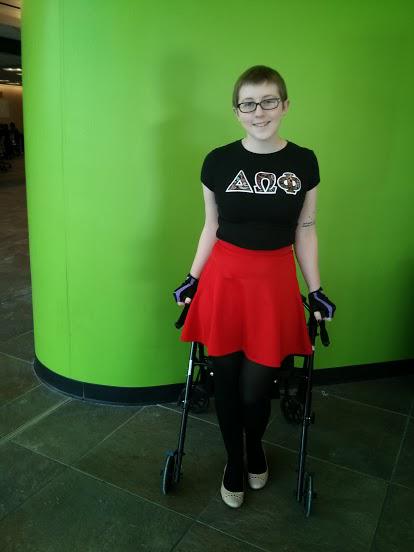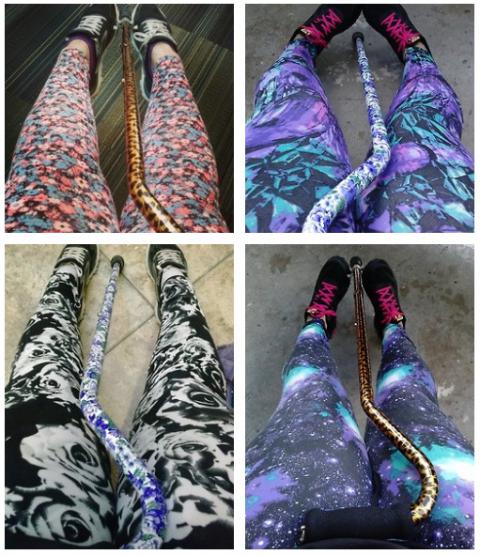October 9, 2014 - 00:37

Defining Portraiture
It is often, at least in my opinion, a faux pas to begin a paper beyond grade school with a dictionary definition. That said, I think some dictionary definitions can get the proverbial ball rolling.
Portrait, n. A drawing or painting of a person, often mounted and framed for display, esp. one of the face or head and shoulders; (also) an engraving, photograph, etc., in a similar style.
Garland-Thomson gives several examples of what makes a portrait and how these parts can be molded to re-present people with disabilities in new, more humane and ethical ways. She begins with frame, talking about the literal frame of classical portraits and the aesthetic choices of materials to surround the oil paintings (Sandell, Dodd, and Garland-Thomson 26). I think, however, that this definition of frame is narrow.
There are many mediums of portraiture, but also many modes of circulating portraiture as well. Arguably, the method of circulation is also a “frame”. The place and presentation of a portrait are equally part of its frame. For example, there a many connotations in putting a portrait into a museum; doing so would imply that the subject and artist are of worth for consumption, predominantly in and by upper-scale society, and that the portrait is of some cultural value.
The Selfie
The Oxford English Dictionary added a new colloquial definition to its repertoire in June this year (2014).
Selfie, n. A photographic self-portrait; esp. one taken with a smartphone or webcam and shared via social media.
In my experience, myself or and others in my age group (teens, early twenties) have associations with the term ‘portrait’ that often involve either the distance of a museum or the distance of old photography/paintings of long deceased relatives.
Selfies, however, are made to be consumed by most anyone*. The selfie is a specific kind of portraiture that is made to be shared and to be created by anyone. Historically, to have one’s portrait created was a class and power marker (Sandell, Dodd, and Garland-Thomson 26, 28). Selfies put to question such a concept. A large portion of the word’s global community has access to a computer or mobile phone with which a person could take and share a photograph, thus erasing some of the inherent inaccessibility of portraiture.
*It is important to note that, while selfies can be created by people who are less sighted, that the visually impaired and blind community may not interact with selfies in the same way. That said, this does not inherently inhibit one from being the subject of a selfie.
Selfie Study
Carson

[The original image can be found here]
Carson, the subject, posted her selfie on tumblr, where I was able to retrieve her name and pronouns.
This selfie presents us a full frontal view, and Carson stands with one foot slightly up as she balances on her walker. The frontal pose allows for the viewer to see all of her, walker and all. This does not necessarily emphasize her walker use, but does integrate it into a larger picture of herself and how, in this instance, it is connected to her. This connection comes with her gloves, which almost makes the walker visually blend into her. The green background is very different from what she’s wearing; her black top is a bit muted and melds in with her walker as well (though not to the same extent as her gloves), and the green really emphasizes her the red of her skirt. This emphasis draws attention to the skirt and thus her gender presentation.
She is looking directly at the viewer, though not confrontationally; she is smiling, but her gaze gives a feeling of autonomy and authority over self.
Her pose also emphasizes what her clothes show – her gender/presentation as a femme woman. Her skirt, tights, shirt, and shoes are very effeminate. Given that this is a self-portrait, we know that she is owning of this gender.
Given the femme presentation, the very short hair of the subject plays with queering of gender without actually de-gendering her. While short hair is not inherently a sign of queer sexuality, I believe it is here. The “tags” on the post include “#disabled femme”, which has some connotations of sexuality.
The subject is slightly off center but still takes up the majority of the photo. The placing of her off-center, though, ensures that the viewer sees her as ‘palatable’ in her disability, rather than if she were standing in the middle of the photo and being direct, which would be more confrontational.
Kat

[The original images can be found here]
These selfies are also taken from tumblr, but from a different blog. The tumblr user’s name is Kat, and Kat is the subject in all four of these selfies. Kat goes by they/them/their pronouns.
While portraits are usually representations “of the face or head and shoulders”, Kat’s selfies are of their legs and cane(s). Often in portraits, especially of disabled people, the images will focus on making the image as normative and palatable as possible. Kat, however, centers their cane on their lap, making not only the pose and composition non-normative, but also the attention is placed on the tool for their non-normative body/impairment.
The centering of their legs and cane also calls attention to the patterns. The backgrounds are drab, consisting mostly of grays, which allow the “busier” patterns and colors to pop that much more. Because Kat’s leggings and cane are differently patterned, this also draws the viewer’s gaze to the ways in which these patterns interact. In some, the colors almost purposefully clash, and generally, the pattern shapes match more generally than the colors. It is in my experience that queer (and by extension, femme) fashion often uses such markers to add emphasis to the non-normativity of the wearer. Thus, the cane is an extension of Kat’s gendered fashion.
However, since the cane is placed alongside their legs so pointedly, it seems more implied that the cane is almost a “third leg”* rather than a fashion accessory. Also, the cane and leg/feet poses in each selfie are just slightly different in ways that focus on small action. This gives action to the cane user themself, which is important to note given that often representations of mobility-impaired folks center on their impairment or stagnancy. In posting the pictures as a set, the viewer can note the different poses, which creates a sort of movement within this two-dimensional medium.
As mentioned previously, Kat’s fashion in these selfies coincide with my knowledge of queer fashion. The term femme is an extension of that queerness. They also use the tumblr tag “#disabled femme”.
*Note: I know this is also a euphemism for a penis, but that’s not the point of the phrasing here. Arguably, the placement of the cane could be seen as phallic, as was pointed out to me by a peer, but I don’t believe at all that was Kat’s purpose. Instead, as a fellow cane-user, I just like using cane-user jokes and say “third leg” ironically when that’s obviously also a euphemism.
Selecting Selfies
Also, both selfies are strong forces in gendering their subjects. Both identify in the “tags” of their posts (an option on tumblr that is a kind of “hashtagging”) as “disabled femme”. I could tell this connection without knowing both subjects used this language to describe their selfies; one can gather this active gendering of their bodies and persons. However, it is important to note these markers of self-identification, given that both femme and disabled are somewhat reclaimed identities. Together, the disabled femme identity is almost a direct comment about agency and the engendering instead of degendering, as disabled people are often degendered especially when represented.
Selfies for Disabled Folks (Youth)
Access
Virtually anyone can access selfies in some way. Whether it is by viewing, creating, or being the subject of a selfie, people of varying abilities can be involved in the process of the selfie. Other modes of self-portraiture do not have this entry-way, as often there is some kind of access or skill needed. Here, the only resource would be a camera a device with internet connection. The subjectivity of the selfie and the ability needed to interact with selfies is extremely important to those with disabilities and how to represent themselves. The viewer or selfie subject can interact with the selfie as needed or wanted.
There is still some form of financial resource necessary to have technology, and often a certain level of motor skill/sight associated with taking/viewing selfies. This should not be ignored. However, there is more flexibility with the selfie than with most other portraiture.
Community
Being on internet communities does not focus on or need a literal face to relating experiences. For example, the viewer can learn about Kat’s gender presentation and identity as well as their ability from these portraits. Kat does not have to show their face, but can still be very intentional about the visual narrative they reveal. This allows to create connection outside of a normative “face-to-face” model that is not even be accessible for some.
Online communities have been very formative in identity construction for the current younger generations, myself included. This is because the internet has allowed for community building that goes far beyond physical location and connects people through shared likes, dislikes, or any general shared experiences. Because of this, self-representation now extends beyond the physical self to include a virtual self that is just as valid experientially. However, self-representation can be more complicated by this "virtual" identity, especially when trying to connect the virtual with the physical. Selfies can bridge this gap.
Finding (or building) community can be an important part of having agency. The selfie, when shared over social media, can provide a connection to people of similar experience in the way that stories or text cannot, since, again, pictures provide a visual narrative of experience. Not only do selfies connect the physical and virtual self, but they can also aid in the creation of community.
Agency
As with the two subjects that I studied, the self-presentation is very intentional. There is obvious care given to their gender and ability presentations especially, which seems to be both their focuses.
In making one’s self into the subject, this gives the disabled person full agency and control. Even as we see Carson’s photograph, which she did not take herself, she was able to provide feedback and select how she wanted to be seen in social media by posting this particular picture. This feedback still places the agency back onto the subject in such a way that much other portraiture does not.
Works Cited
"portrait, n., adv., and adj." OED Online. Oxford University Press, September 2014. Web. 8 October 2014.
"selfie, n." OED Online. Oxford University Press, September 2014. Web. 8 October 2014.
Sandell, Richard, Jocelyn Dodd, and Rosemarie Garland-Thomson. "Picturing People with Disabilities: Classical Portraiture as Reconstructive Narrative." Re-presenting Disability: Activism and Agency in the Museum. London: Routledge, 2010. Print.
